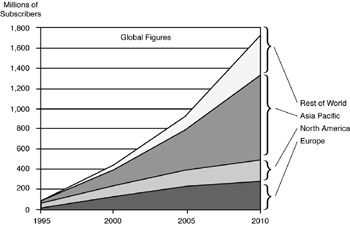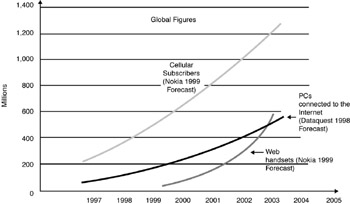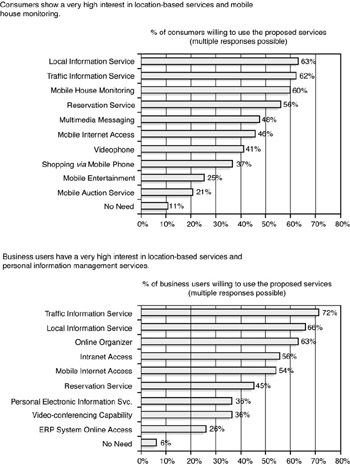The Potential Opportunity
|
|
Figure 1-2 depicts the expected growth in subscribers in the United States for major wireless technologies based on information from 2002. Approximately 105 million people will use mobile data services in 2005 (with 80 million on 2G/2.5G systems and 25 million on 3G systems). As can be seen in this figure, there are major opportunities for all types of data-enabled wireless services, spanning the WPAN, WLAN, WWAN, and hotspot arena. 3G services are expected to be widely available in the United States from 2005 on. It is expected that there will be 25 million subscribers in 2005 in the United States out of a base of 201 million mobile users who will be on 3G systems in 2005, and the number is expected to grow to 171 million out of a base of 229 million by 2010. 3G will support location-based services for business and residential customers.

Figure 1-2: Anticipated growth of mobile data/3G users in the United States (Source: Dresdner Kleinwort & Siemens Mobile Network marketing data)
Figure 1-3 provides global numbers. The demand for wireless services has experienced major growth in the past 20 years. Since the introduction of generally available cellular service in 1981, it has experienced a compounded annual growth around 40 percent; by comparison, regular telephone service has only experienced a 5 percent annual growth. The majority (almost totality) of traffic on WWAN networks today is voice oriented, but the demand for data and Internet services is becoming pronounced (see Figure 1-4).

Figure 1-3: Anticipated growth of wireless users worldwide (Source: UMTS Forum)

Figure 1-4: Data-enabled wireless units will equal the number of PCs in the near future. (Source: Nokia)
The WLANs and hotspot service now being deployed will eventually drive the evolution to 3G. According to research conducted by Siemens Mobile, a plethora of wireless-oriented services are of interest, as shown in Table 1-2. Revenue services that are being considered include advertisement (personalized, location specific, and push/pull), mobile commerce (including the commissions of products sold), and event-driven services (also including transmission charges). Both business and residential customers have expressed a 'high interest in location-based services,'[8] as illustrated in Figure 1-5, which is also based on market research data from Siemens. Industry leaders hope that the decreasing mobile voice average revenue per user (ARPU) will be compensated by increasing mobile data ARPU (see Figure 1-6).[9]
| Residential User Segment | Business User Segment |
|---|---|
|
|
|
|
|
|
|
|
|
|
|
|
|
|
|
|
| |
| |
| Source: Siemens Mobile Networks Marketing, end-user survey 2001 | |

Figure 1-5: Interest in location-based and other wireless/nomadic services (Source: Siemens Mobile Networks [2001 data])

Figure 1-6: Revenues for location-based and other wireless/nomadic data services
Major opportunities continue to exist in the data wireless space, as implied by the following quote:
. . . Cisco is betting that tornado markets will spur new business this decade, much the way the Internet opened a torrent of new opportunities during the past one. The tornado markets include Internet-based phone systems for businesses, wireless networks for home and offices, Internet-based systems to streamline the way corporations store data, and gear that reduces Internet traffic congestion by putting copies of popular digital content on computers in multiple geographic locations. A fifth twister is the gear for building metropolitan fiber-optic networks, the speedy on-ramps that connect the long haul to local traffic centers. Cisco conservatively estimates these markets at $20 billion, and $40 billion by 2004.[10]
It has been noted that 'from airport lounges and hotel meeting rooms to coffee shops and restaurants across the globe, a wireless world is being built for mobile professionals to stay connected.'[11] Now that key standards have emerged and other ancillary standards are being developed, enabling low-cost development, supportive devices are poised to rapidly penetrate the consumer and professional networking market. Many end users are interested in mobile devices that can deliver web content to smaller form factors, whether they are in their home base or on the move. According to recent Cahners In-Stat Group's market data,[12] public area network services in hotels, convention centers, and airports are poised to flourish in the coming years. For example, they projected $180 million of service revenues in 2002.
There will be significant investment in the future wireless data space. Gartner put the WLAN market at $1.4 billion in 2001, and estimates that it will grow to $1.7 billion in 2002 and $3.8 billion in 2006. Wireless network interface cards (NICs) were counted at 5 million in 2001 and are forecast to be 9 million in 2002 and 40 million in 2006.[13] The per-unit cost of WLAN connection hardware has been dropping rapidly. Although WLANs continue to see penetration in vertical applications, interest is also growing in horizontal settings; some see the eventual emergence of a totally wireless campus. The overall 802.11b market is expected to keep growing at a healthy rate despite the economic slowdown of the early 2000s, according to an April 2001 report by Cahners In-Stat Group.
Statements such as the following are typical:
While it is hard to be bullish about anything these days, the Boston, Massachusetts-based Yankee Group is extremely gung-ho about wireless field (in its most general manifestation). If the research firm is right, wireless penetration will double over the next five years - reaching 21 percent of the world's population by 2006, or a total of 1.3 billion subscribers. That is a bold forecast considering the market slowdown. Currently, wireless penetration amounts to 10.6 percent of Earth's 6 billion people, according to the Yankee Group.[14]
The total wireless revenues worldwide were placed at $200 billion in 1998 and $400 billion in 2002 by ITU sources.
According to Cahners In-Stat Group, the business WLAN market was remarkably resilient over the course of 2001; it experienced a growth rate that exceeded expectations, even in the midst of the technological economic downturn. The year was buoyed by strong sales to verticals, including education, retail, financial, and healthcare. From a horizontal standpoint, Fortune 500 companies built out their existing WLAN networks, and small and medium businesses moved to embrace WLANs. Asia Pacific and Europe remained strong geographic segments, but North America grabbed the lion's percentage of the market.[15]
Although the first half of 2001 was marked by indications of an economic downturn, Cahners In-Stat Group expected the WLAN market to show healthy growth throughout the forecast period. In the LAN space, wireless networking is the next step, and Cahners In-Stat Group apparently believes that shipments will continue to grow as prices fall and new technologies bring increased speeds. They state that by 2005, the total enterprise WLAN end-use revenues will be $4.6 billion. Throughout the forecast period, revenues will grow significantly less than shipments as prices continue to fall steeply. The driving force in the WLAN market will be Wi-Fi products, including 802.11b and 802.11g products. These products have been especially successful in penetrating the education, hospitality, healthcare, and financial environments and, as prices fell in 2001 and the beginning of 2002, other industries have adopted them at a high rate. Also, the push of these products into areas outside of North America will continue. In 2002, the growth rate in end-use revenues was expected to increase as comparatively high-priced 5 GHz products are introduced into the market.
As noted, there is a longer-term trend for always-on, always-active, and always-connected environments created by wearable computers. In the not too distant future, wearable computers will be met with the same interest that handheld computers are met with today, according to proponents. Loosely predicted, by 2006, progress made in the fields of wireless short-range communication and battery capacity will make it possible for anyone to carry an always-on link to the Internet or any other network.[16] Gartner predicts that by 2010, 40 percent of adults and 75 percent of teenagers will be utilizing wearable devices, and 70 percent of the population will spend 10 times longer a day interacting with people in the cyberworld rather than in the physical world.
Some companies like Levi-Strauss are already advancing the wearable concept by offering a jacket that incorporates a hidden MP3 player and mobile telephone connected to a microphone and remote control in the collar. Some wearable devices are already available for less than $300.[17] As another example, Mitsubishi Electric's R&D lab recently showed a prototype of a new wearable display that, unlike most other wearable displays, positions the liquid crystal display (LCD) piece under the user's eyes. The idea behind this concept is to enable users to switch more easily between looking at the display and to have a full visual range than what is possible with most current solutions, where the user's view is most often occupied entirely by a display piece placed in front of the user's eye. The near-term goal is to connect these wearable computers' IP appliances to the Internet.[18]
[8]K. Florschutz, '3G Wireless, Meeting High Expectations,' Next-Generation Networks Conference (NGN), Boston, Mass., November 2001.
[9]Data from Siemens, Salomon Smith Barney, and JP Morgan, 2002.
[10]Wall Street Journal, July 19, 2001.
[11]IEEE Institute Magazine (July 2001).
[12]Networkworld (May 28, 2001).
[13]D. Molta, 'Mobile and Wireless Technology,' Network Computing (December 17, 2001): 37 ff.
[14]Dan McDonough, Jr., Wireless News Factor, July 16, 2001.
[15]www.instat.com/abstracts/ln/2001/ln0110wl_abs.htm.
[16]Jørgen Sundgot, 'A Wearable Handheld?' www.infosync.no/show.php?id=469, September 2, 2002.
[17]Matias Corporation, www.halfkeyboard.com.
[18]Jørgen Sundgot, 'New Wearable Display from Mitsubishi,' www.infosync.no/show.php?id=1262, September 2, 2002.
|
|
EAN: N/A
Pages: 88